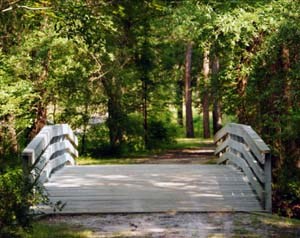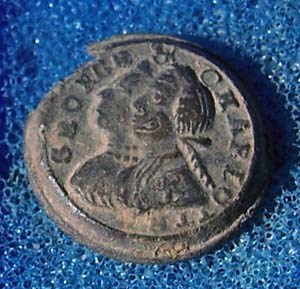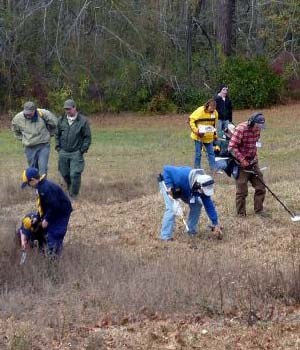Last updated: June 21, 2021
Article
Archeological Discoveries at Moores Creek National Battlefield

NPS.
A recent NPS NHPA compliance project at Moores Creek National Battlefield(NB), 19 miles north of Wilmington, North Carolina, offered archeologists an opportunity to verify whether the 1776 Battle of Moores Creek actually took place within the national battlefield boundaries. The Battle of Moores Creek Bridge was one of the first Revolutionary War engagements in the South, pitting American Patriots against Loyalists from North Carolina. In December 2011, NPS archeologists and resources managers conducted an archeological survey to locate the battlefield with the help of the Eastern North Carolina Metal Detecting Association and volunteers from the Department of History at the University of North Carolina, Wilmington. One of the goals of the project was to recover artifacts to prove that the battle was actually fought at the purported site.
The Battle of Moores Creek Bridge
By the summer of 1775, the lines between the North Carolina Patriots, commanded by Colonel Richard Caswell and Colonel Alexander Lillington, and the Loyalists, under the command of General Donald MacDonald, were clearly drawn. Caswell’s militia and Lillington’s Wilmington District Minutemen combined forces with the First North Carolina Continentals, commanded by Colonel James Moore. Together, the three groups maneuvered to position themselves in ideal locations to meet an attack by the Loyalists.
After losing control of the North Carolina colony to Patriot dissidents, Royal Governor Josiah Martin fled the capital of New Bern in June of 1775, seeking refuge with a small garrison of British troops at Fort Johnston, located in present day Southport, North Carolina, near the mouth of the Cape Fear River. Six weeks later, the North Carolina militia pushed Loyalists out of the fort and onto the Cruzier, a British warship. That autumn, after this embarrassment, Governor Martin requested British troops be sent to join forces with North Carolina Loyalists which was comprised of Highlanders (conservative Scottish immigrants), Tories and former Regulators, deemed to be “the officers of this county [who are] under a better and honester [sic] regulation than any have been for some time,” (Hatch 1969:3). Governor Martin was confident that this makeshift army of approximately sixteen hundred men would rally to King George III’s flag. Governor Martin authorized General Donald MacDonald to muster a Loyalist army at Cross Creek (present-day Fayetteville, North Carolina) and march toward Wilmington in late February 1776. Planning to invade the North Carolina colony, this army of Loyalist militia set out on a southbound path via the Cape Fear River Valley.
![[Illustration] Patriot forces firing at soldiers crossing creek. [Illustration] Patriot forces firing at soldiers crossing creek.](/articles/images/morresCreekPatriotMilitia.jpg?maxwidth=650&autorotate=false)
NPS.
Unfortunately for Josiah Martin, American Patriots intercepted the Governor’s printed proclamation of January 10, 1776. As a result, Colonel James Moore blocked the Loyalists’ path down the south side of the Cape Fear River, forcing them to alter their route to the north bank. On February 26, Caswell’s 800 man militia arrived at Moore’s Creek to join with Lillington’s Minutemen. That night they camped behind their newly constructed earthwork entrenchments on the east side of the bridge that spanned the 50 feet wide creek. Six miles away, General MacDonald’s Loyalist army camped along the western side. A combined force of about 900 of Caswell’s militia and Lillington’s Minutemen clashed with the Loyalists at Widow Elizabeth Moore’s bridge at dawn on February 27, 1776.
In a moment of creativity, the Patriots had removed most of the planks from the Widow Elizabeth Moore’s bridge and greased the remaining girders with soft soap. The young Loyalist Lieutenant Donald MeLeod led his men carefully across the bridge, stabbing their swords into the wooden supports to hold steady. Upon reaching the eastern Patriot encampment, Loyalists were met with a volley of musket balls and artillery canister, killing or mortally wounding about 30-40 Highlanders and Tories. On the Patriot side only one man, John Grady, was mortally wounded during the battle.
The shooting lasted only a few minutes but resulted in a decisive Patriot victory, failure for Governor Martin’s campaign, and suppression of Loyalist activity in Southeastern North Carolina. The Patriot success at Moores Creek demonstrated the extent of their strength in the countryside. The victory emboldened the North Carolina Provisional Congress to pass the Halifax Resolves on April 12, 1776, instructing the colony’s delegates to vote in favor of independence from Great Britain at the next meeting in Philadelphia.

Photo by PRGringo.
Investigations at Moores Creek
Archeological excavations at Moores Creek National Battlefield since 1937 had failed to uncover any material culture associated with the battle, and underwater archeologists found no evidence of the 18th-century bridge that separated the opposing forces. This is not surprising, as the area was heavily farmed prior to park designation. The constant churning of the plow’s blade may account for the limited archeological finds. Investigations were expected to produce artifacts that would include the metal parts of guns and rifles, shot, buckles, and buttons; however, test pits and excavation units turned up little cultural material. No trace of a camp or the manmade earthworks that served as protective walls were ever located. No Revolutionary War artifacts were recovered from the supposed location of these works. Five metal objects that were located in the 1950s could not definitively be ascribed to the period or battle as well. Thus, absence of these military-associated artifacts and remnants of a bridge gave rise to the theory that the engagement did not occur at the park, although it has been recognized as the battlefield since 1856.
The 2011 investigations at Moores Creek uncovered about two dozen lead musket and rifle balls, a British penny dated 1738, and a commemorative button from the marriage of King George III and Queen Charlotte of Mecklenburg-Strelitz. The British monarchs were married in 1761, only 15 years before the Battle of Moores Creek occurred. The lack of artifacts was, in part, due to trespassing relic hunters who took artifacts from the remote property for years. Nevertheless, the material culture that archeologists uncovered provides convincing evidence that the Battle of Moores Creek Bridge did indeed take place within the already recognized national battlefield area.

NPS photo by the Southeast Archeological Center.
Metal Detecting In Battlefield Archeology
This evidence would not be easily located without the assistance of experienced metal detecting hobbyists, although in the past fifty years, metal detecting has developed into much more than a hobby. Increasing amounts of historical and battlefield archeological investigations are now utilizing this less intrusive method for detecting potential artifacts. In 1958, archeologist John W. Griffin found metal detecting at significant subsurface depths to be ineffective and saw little use for the technology in the recovery of battlefield artifacts. Today, metal detectors are able to detect objects 15-20 inches below ground surface and differentiate between different types of metal. This ability allows archeologist to discriminate between iron, aluminum, lead, gold and silver, and to save valuable time and energy excavating relevant objects.
At Moores Creek, NPS archeologists and Dr. Chris E. Fonvielle, Jr. from the Department of History at UNC Wilmington, were assisted by the Eastern North Carolina Metal Detecting Association. Ken Blevins, president, and a team were assisting state archeologists at Fort Anderson, a Civil War site in Winnabow, North Carolina, when he was approached by James Sutton, Resource Manager at Moores Creek NB, to help locate military artifacts in the park.
In a telephone interview (Blevins, pers. comm. date), Blevins described the survey method: association members lined up in a straight line and proceeded straight forward in search of artifacts. For two days, more than eighteen association members scoured the fields in one long line. When an object was found, archeologists tagged the location with a flag and recorded the GPS coordinates. According to Blevins, quite a few buffalo nickels, hay pennies, and 1800s-1900s reproduction buttons were found. The major finds, musket balls, a 1700s coin and period buttons, were located between 2 inches and 8 inches below the surface. The association also used the fieldwork to teach future metal detector enthusiasts from the Boy Scout and Cub Scout troops that visited that weekend about archeological metal detecting.
Blevins reported that there is a good chance another survey of Moores Creek will take place, “We just took the top layer,” he says, referring to the few relevant artifacts and the many non-related objects, “There is probably more out there.” This time, Blevins would like to survey within a gridded field to make sure no area is missed. “Anytime we can help out the park or state, we’re more than willing.” Blevins commented, “Anytime we’re able to save history, it’s exciting!”
From an article by Dr. Chris Fonvielle Jr., Historian at University of North Carolina, Wilmington. Adapted by Christine Oricchio, Intern, NPS Archeology Program, WASO.
References
Blevins, Ken personal communication, February 13, 2012. Blevins is President of the Eastern North Carolina Metal Detecting Association.
Hatch, Charles E. Moores Creek National Military Park, North Carolina: the Battle of Moores Creek Bridge. Office of History and Historic Architecture, Washington: 1969.
